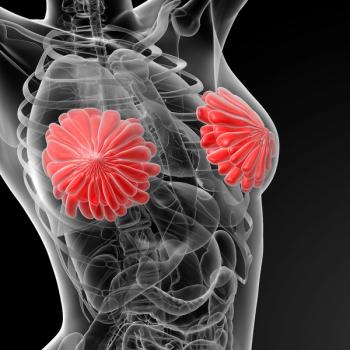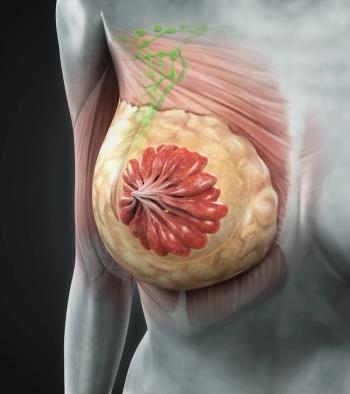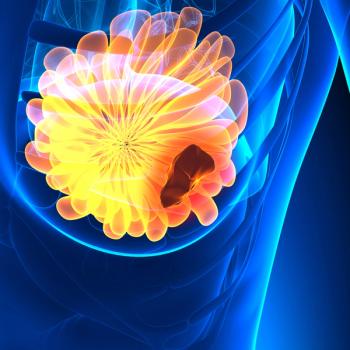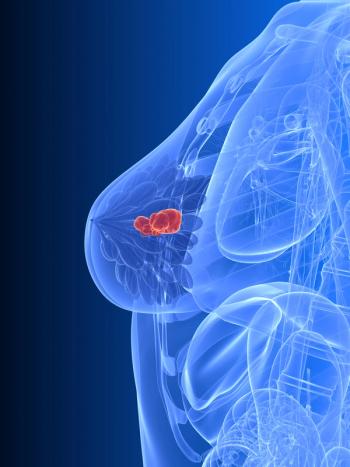
- ONCOLOGY Vol 12 No 3
- Volume 12
- Issue 3
Quality of Life Issues in the Treatment of Metastatic Breast Cancer
The treatment of metastatic breast cancer involves the sequential selection and delivery of hormonal therapies and cytotoxic chemotherapies. The available therapies for metastatic breast cancer are rarely curative, although high rates of response and modest prolongation of survival may be achieved in association with varying degrees of treatment-related toxicity.
ABSTRACT: The treatment of metastatic breast cancer involves the sequential selection and delivery of hormonal therapies and cytotoxic chemotherapies. The available therapies for metastatic breast cancer are rarely curative, although high rates of response and modest prolongation of survival may be achieved in association with varying degrees of treatment-related toxicity. Therefore, the selection of appropriate therapy requires a reasoned consideration of the likelihood of benefit from therapy balanced with the impact of therapy on the patient’s quality of life. Several instruments have been developed to measure quality of life in cancer patients, but none has been universally accepted, and they require time and resources to administer. Few randomized clinical trials have incorporated quality of life assessments. Thus, the clinician must balance antitumor activity, performance status, and the usual toxicity measures, (eg, nausea, myelosuppression, asthenia) as surrogates for quality of life associated with each specific therapy. Studies have confirmed the clinical impression that antitumor activity of treatment generally correlates with quality of life outcome. The hormonal therapies have the quality of life advantages of limited and non-threatening acute toxicity, rare chronic toxicity, need for infrequent visits to health care providers, oral administration, and, in appropriately selected patients, response and duration of response rates equivalent to those of the cytotoxic agents. A number of cytotoxic agents have activity in the treatment of metastatic breast cancer. Although the active single agents differ substantially in their toxicity profiles, the dose-limiting toxicity is usually myelosuppression. Recently, several agents with substantial activity against breast cancer have become available, including the taxanes (paclitaxel and docetaxel), vinorelbine, and gemcitabine. Oral formulations of vinorelbine are being studied that may provide the additional advantage of not requiring intravenous access, requiring fewer visits to the health care professional, and providing patients with a greater sense of control of their treatment. [ONCOLOGY(Suppl 4):27-31, 1998]
The contemporary systemic treatment of metastatic breast cancer involves the sequential selection and delivery of hormonal therapies and cytotoxic chemotherapies. The available therapies for metastatic breast cancer are rarely curative,[1] although high rates of response and modest prolongation of survival may be achieved in association with varying degrees of treatment-related toxicity. Therefore, selection of appropriate therapy requires a reasoned consideration of the likelihood of benefit from therapy balanced with the impact of the therapy on the patients quality of life. Unfortunately, relatively little objective evidence is available regarding the impact of most systemic therapies on the quality of life of patients with metastatic breast cancer.
The quality of life in patients with cancer has many dimensions (
- Time Without Symptoms and Toxicity (TWiST)
- Quality of Time Without Symptoms and Toxicity (Q-TWist)
- Quality-Adjusted Life Year (QALY), Quality of Well Being (QWB)
- Cancer Rehabilitation Evaluation System (CARES)
- European Organization for Research and Treatment of Cancer QLQ-C30
- Functional Assessment of Cancer Therapy (FACT)
- Functional Living IndexCancer (FLIC)
- Selby Linear Analogue Self-Assessment (LASA) scale
- Rotterdam Symptom Check List (RSCL).
All of these instruments require time and resources to administer and expertise to analyze. As a result, the use of the quality of life instruments has been limited primarily to research studies involving women with local-regional breast cancer. Even in the research setting, few randomized clinical trials have incorporated quality of life assessments other than the use of measurements of physical performance by the Karnofsky or Eastern Cooperative Oncology Group (ECOG [Zubrod, World Health Organization]) scales.[8,9] Instruments that efficiently and comprehensibly measure quality-of-life will be required before routine quality of life measurements will be used in the nonresearch setting.
In the absence of formal quality-of-life assessments in clinical trials, the clinician must balance antitumor activity, performance status, and the usual toxicity measures (eg, nausea, myelosuppression, asthenia) as surrogates for quality of life associated with each specific systemic therapy.
The hormonal therapies have the quality-of-life advantages of limited and usually non-threatening acute toxicity, rare chronic toxicity, need for infrequent visits to health care providers, oral administration, and, in appropriately selected patients, response and duration of response rates equivalent to the cytotoxic agents. Tamoxifen (Nolvadex) remains the most commonly used first-line hormonal agent and has a favorable and acceptable toxicity profile. New estrogen antagonists (toremifene [Fareston], droloxifene) appear to have therapeutic indices similar to those of tamoxifen, although further study is needed before firm conclusions may be made.[10,11] The recent addition of new aromatase inhibitors (anastrozole [Arimidex], letrozole [Femara]) for the treatment of postmenopausal women provides increased ease of administration, decreased acute and chronic toxicity, and excellent rates of response in comparison with aminoglutethimide (Cytadren) and many of the other second- and third-line hormonal agents.[12-14]
A number of cytotoxic agents have activity in the treatment of metastatic breast cancer. The active single agents differ substantially in their toxicity profiles, although the dose-limiting toxicity is usually myelosuppression. Combination chemotherapy regimens are usually used for first-line cytotoxic treatment of metastatic breast cancer. When cytotoxic agents are used in combination regimens, the toxicity experienced is a combination of that observed with the single agents. Because of their additive nature, the most frequently used combinations (eg, CMF [cyclophosphamide/methotrexate/5-fluorouracil], CAF [cyclophosphamide/Adriamycin/5-fluorouracil]/FAC, CEF [cyclophosphamide/epirubicin/5-fluorouracil]) have similar rates of response and toxicities.
Response Predicts Quality of Life
An early study addressed the quality of life of women with metastatic breast cancer using a linear analogue self-assessment scale.[15] This study compared the quality of life of women with metastatic breast cancer randomized to receive hormonal therapy versus combination chemotherapy with cyclophosphamide (Cytoxan, Neosar), doxorubicin (Adriamycin), 5-fluorouracil (5-FU) and vincristine (Oncovin). A total of 25 parameters of quality of life were measured, and, as expected, patients receiving cytotoxic therapy experienced more alopecia, nausea, vomiting, and constipation than those treated with hormonal maneuvers. However, there was a trend toward improved well-being in patients receiving cytotoxic therapy that became statistically significant by week 11 of therapy. This study was initiated prior to the availability of reliable hormone receptor determinations that would have selected a cohort of women who are likely to respond to hormonal therapy (
A trial in women with metastatic breast cancer compared treatment with continuous versus intermittent CMF plus prednisone or doxorubicin plus cyclophosphamide chemotherapy.[16] Patients in the continuous arm received chemotherapy until progression of disease, while those in the intermittent arm received three cycles of chemotherapy and then received additional chemotherapy only at the time of progression. Continuous chemotherapy was associated with higher rates of response and superior time to progression. There was a trend toward superior survival with continuous treatment. Surprisingly, both patient and physician assessments of patient quality of life were superior for those patients receiving continuous therapy. This confirms findings from the earlier study of Baum et al[15] that response is associated with improved quality of life.
Another trial incorporating a quality-of-life assessment compared two dose levels of CMF in patients with metastatic breast cancer.[17] Higher dose CMF compared with lower dose CMF was associated with improved rates of response, improved median survival, and more vomiting, myelosuppression, conjunctivitis, and alopecia. The quality of life assessment demonstrated similar scores for both the higher and lower dose CMF regimens, although most scores favored the higher dose regimen. Thus, the higher dose CMF regimen appeared to produce superior palliation compared with the lower dose CMF regimen.
Recently, several new cytotoxic agents with substantial activity against breast cancer have become available. These agents include the taxanes (paclitaxel [Taxol] and docetaxel [Taxotere]) and vinorelbine (Navelbine).
Paclitaxel
In single-agent phase II trials in women with metastatic breast cancer, paclitaxel appears to result in response rates of 23% to 56% (
Docetaxel
Single-agent docetaxel results in rates of response of 32% to 68% in patients with metastatic carcinoma of the breast (
Vinorelbine
Vinorelbine has demonstrated single-agent rates of response of 32% to 52% in patients with metastatic breast cancer (
An oral formulation of vinorelbine is available for research purposes and may provide the advantage of not requiring intravenous access, requiring fewer visits to the health care professional, and providing the patient with a greater sense of control of their treatment. Early studies do suggest an increased rate of gastrointestinal toxicities, but these toxicities appear to be manageable with prophylactic antiemetic and antidiarrheal agents.[46,47]
Gemcitabine
Gemcitabine (Gemzar), another new agent, appears to have activity in some early clinical trials, with response rates of 0% to 46% (
Combination Regimens Using New Cytotoxic Agents
The toxicity profiles of the new single agents allow their exploitation as components in combination chemotherapy regimens. These combination chemotherapies use multiple active cytotoxic agents and generally have high rates of response but with increased severity of hematologic and nonhematologic toxicities. Whether these regimens will be associated with superior durations of response and survival and improved quality of life awaits the completion of randomized clinical trials.
There is a need for the further development and use of valid, reliable, easily administered and scored measures of quality of life. Only with the availability of studies incorporating quality-of-life measures across multiple dimensions will patients and physicians be able to balance treatment activity with quality- of-life considerations.
Dr. Weeks: You talked about the possible role of vinorelbine as an oral agent for women with metastatic breast cancer. Are oral combination regimens a viable option in this setting?
Dr. Carlson: Yes. Oral combination regimens offer an excellent approach for patients with metastatic breast cancer. One difficulty, however, is that relatively few of the agents active against metastatic breast cancer can be administered orally. The vinca alkaloids and the anthracyclines, for example, cannot be given orally, at least not yet. Certainly the alkylating agents can be given as part of combination treatment. I am not aware of any randomized trials assessing oral combination regimens for patients with metastatic breast cancer.
References:
1. Greenberg PAC, Hortobagyi GN, Smith TL, et al: Long-term follow-up of patients with complete remission following combination chemotherapy for metastatic breast cancer. J Clin Oncol 14:2197-2205, 1996.
2. Donovan K, Sanson-Fisher RW, Redman S: Measuring quality of life in cancer patients. J Clin Oncol 7:959-968, 1989.
3. Moinpour CM, Feigl P, Metch B, et al: Quality of life end points in cancer clinical trials: Review and recommendations. J Natl Cancer Inst 81:485-495, 1989.
4. Winer EP: Quality of life research in patients with breast cancer. Cancer 74:410-415, 1994.
5. Fallowfield LJ: Assessment of quality of life in breast cancer. Acta Oncol 34:689-694, 1995.
6. Osoba D: Health-related quality of life as a treatment endpoint in metastatic breast cancer. Can J Oncol 5(suppl):47-53, 1995.
7. Hietanen PS: Measurement and practical aspects of quality of life in breast cancer. Acta Oncol 35:39-42, 1996.
8. Karnofsky DA, Adelmann WH, Craver LF, et al: The use of nitrogen mustards in the palliative treatment of carcinoma. Cancer 1:634-656, 1948.
9. Zubrod CF, Schneiderman M, Frei E, et al: Appraisal of methods for the study of chemotherapy of cancer in man: Comparative therapeutic trial of nitrogen mustard and triethylene thiophosphoramide. J Chronic Dis 11:7-33, 1960.
10. Tellez C, Jordan VC: Hormonal treatment of advanced breast cancer. Surg Oncol Clin North Am 4:751-777, 1995.
11. Wiseman LR, Goa KL: Toremifene: A review of its pharmacological properties and clinical efficacy in the management of advanced breast cancer. Drugs 54:141-160, 1997.
12. Miller WR: Aromatase inhibitors and breast cancer. Cancer Treat Rev 23:171-187, 1997.
13. Buzdar AU, Jones SE, Vogel CL, et al: A phase III trial comparing anastrozole (1 and 10 milligrams), a potent and selective aromatase inhibitor, with megestrol acetate in postmenopausal women with advanced breast carcinoma. Cancer 79:730-739, 1997.
14. Anonymous: New aromatase inhibitors for breast cancer. Drug Ther Bull 35:55-56, 1997.
15. Baum M, Priestman TJ, West RR, et al: A comparison of subjective responses in a trial comparing endocrine with cytotoxic treatment in advanced carcinoma of the breast, in Mouridsen HT Palshof T (eds): Breast CancerExperimental and Clinical Aspects, pp 223-226. Oxford, New York, Pergamon Press, 1980.
16. Coates A, Gebski M, Bishop JF, et al: Improving the quality of life during chemotherapy for advanced breast cancer: A comparison of intermittent and continuous treatment strategies. N Engl J Med 317:1490-1495, 1987.
17. Tannock IF, Boyd NF, DeBoer G, et al: A randomized trial of two dose levels of cyclophosphamide, methotrexate, and fluorouracil chemotherapy for patients with metastatic breast cancer. J Clin Oncol 6:1377-1387, 1988.
18. Holmes FA, Walter RS, Theriault RL, et al: Phase II trial of taxol, an active drug in the treatment of metastatic breast cancer. J Natl Cancer Inst 83:1797-1805, 1991.
19. Wilson WH, Berg SL, Bryant G, et al: Paclitaxel in doxorubicin-refractory or mitoxantrone-refractory breast cancer: A phase I/II trial of 96-hour infusion. J Clin Oncol 12:1621-1629, 1994.
20. Abrams JS, Vena DA, Baltz J, et al: Paclitaxel activity in heavily pretreated breast cancer: A National Cancer Institute Treatment Referral Center trial. J Clin Oncol 13:2056-2065, 1995.
21. Gianni L, Munzone E, Capri G, et al: Paclitaxel in metastatic breast cancer: A trial of two doses by a 3-hour infusion in patients with disease recurrence after prior therapy with anthracycline. J Natl Cancer Inst 87:1169-1175, 1995.
22. Vermorken JB, ten Bokkel Huinink WW, Mandjes IA, et al: High-dose paclitaxel with granulocyte colony-stimulating factor in patients with advanced breast cancer refractory to anthracycline therapy: A European Cancer Center trial. Semin Oncol 22(suppl 8)16-22, 1995.
23. Seidman AD, Reichman BS, Crown JP, et al: Paclitaxel as second and subsequent therapy for metastatic breast cancer: Activity independent of prior anthracycline exposure. J Clin Oncol 13:1152-1159, 1995.
24. Seidman AD, Tiersten A, Hudis C, et al: Phase II trial of paclitaxel by 3-hour infusion as initial and salvage chemotherapy for metastatic breast cancer. J Clin Oncol 13:2575-2581, 1995.
25. Bishop JF, Dewar F, Tattersall MHN, et al: Taxol (paclitaxel) alone is equivalent to CMFP combination chemotherapy as frontline treatment in metastatic breast cancer (abstract 538). Proc Am Soc Clin Oncol 16:153a, 1997.
26. Paridaens R, Bruning P, Klijn J, et al: An EORTC crossover trial comparing single-agent Taxol (T) and doxorubicin (D) as first- and second-line chemotherapy (CT) in advanced breast cancer (ABC) (abstract 539). Proc Am Soc Clin Oncol 16:154a, 1997.
27. Sledge GW Jr, Neuberg D, Ingle J, et al. Phase III trial of doxorubicin (A) vs paclitaxel (T) vs doxorubicin + paclitaxel (A+T) as first-line therapy for metastatic breast cancer (MBC): An intergroup trial (abstract 2). Proc Am Soc Clin Oncol 16:1a, 1997.
28. Neuberg D, Sledge GW Jr, Fetting J, et al. Changes in quality of life (QOL) during induction therapy in patients enrolled in a randomized trial of Adriamycin, Taxol, and Adriamycin plus Taxol in metastatic breast cancer (abstract 185). Proc Am Soc Clin Oncol 16:54a, 1997.
29. ten Bokkel Huinink WW, Prove AM, Piccart M, et al: A phase II trial with docetaxol (Taxotere) in second line treatment with chemotherapy for advanced breast cancer. A study of the EORTC Early Clinical Trials Group. Ann Oncol 5:527-532, 1994.
30. Chevallier B, Fumoleau P, Kerbrat P, et al: Docetaxel is a major cytotoxic drug for the treatment of advanced breast cancer: A phase II trial of the Clinical Screening Cooperative Group of the European Organization for Research and Treatment of Cancer. J Clin Oncol 13:314-322, 1995.
31. Hudis CA, Seidman AD, Crown JP, et al: Phase II and pharmacologic study of docetaxel as initial chemotherapy for metastatic breast cancer. J Clin Oncol 14:58-65, 1996.
32. Chan S, Friedrichs K, Noel D, et al: A randomized phase II study of Taxotere (T) versus doxorubicin (D) in patients (pts) with metastatic breast cancer (MBC) who have failed an alkylating containing regimen: Preliminary results (abstract 540). Proc Am Soc Clin Oncol 16:154a, 1997.
33. Nabholtz J-M, Thuerlimann B, Bezwoda WR, et al: Taxotere versus mitomycin C + vinblastine (MV) in patients (pts) with metastatic breast cancer (MBC) who have failed an anthracycline containing regimen: Preliminary results of a randomized phase III study (abstract 519). Proc Am Soc Clin Oncol 16:148a, 1997.
34. Dieras V, Fumoleau P, Bourgeois H, et al: Taxoids in combination chemotherapy for metastatic breast cancer. Anticancer Drugs 7(suppl 2):47-52, 1996.
35. Toussaint C, Izzo J, Spielman M, et al: Phase I/II trial of continuous infusion vinorelbine for advanced breast cancer. J Clin Oncol 12:1202-2112, 1994.
36. Twelves CF, Dobbs NA, Curnow A: A phase II, multicentre, UK study of vinorelbine in advanced breast cancer. Br J Cancer 70:990-993, 1994.
37. Romero A, Rabinovich MG, Vallejo CT, et al: Vinorelbine as first-line chemotherapy for metastatic breast cancer. J Clin Oncol 12:336-341, 1994.
38. Fumoleau P, Delozier T, Extra JM, et al: Vinorelbine (Navelbine) in the treatment of breast cancer: The European experience. Semin Oncol 22(suppl 5):22-29, 1995.
39. Weber BL, Vogel C, Jones J, et al: Intravenous vinorelbine as first-line and second-line therapy in advanced breast cancer. J Clin Oncol 13:2722-2730, 1995.
40. Terenziani M, Demicheli R, Brambilla C, et al: Vinorelbine: An active, non cross-resistant drug in advanced breast cancer: Results from a phase II study. Br Cancer Res Treat 39:285-291, 1996.
41. Sorio R, Robieux I, Galligioni E, et al: Pharmacokinetics and tolerance of vinorelbine in elderly patients with metastatic breast cancer. Eur J Cancer 33:301-3, 1997.
42. Gasco M, Gardin F, Repetto L, et al. Vinorelbine as palliative therapy in advanced breast cancer. Anticancer Res 17:1431-34, 1997.
43. Jones S, Winer E, Vogel C, et al: Randomized comparison of vinorelbine and melphalan in anthracycline-refractory advanced breast cancer. J Clin Oncol 13:2567-2574,1995.
44. Bertsch LA, Donaldson G: Quality of life analyses from vinorelbine (Navelbine) clinical trials of women with metastatic breast cancer. Semin Oncol 22(suppl 5):45-54, 1995.
45. Budman DR: Vinorelbine (Navelbine): A third-generation vinca alkaloid. Cancer Inves 15:475-490, 1997.
46. Rowinsky E, Noe DA, Trump DL, et al: Pharmacokinetic bioavailability and feasibility study of oral vinorelbine in patients with solid tumors. J Clin Oncol 12:1754-1763, 1994.
47. Winer EP, Chu L, Spicer DV: Oral vinorelbine (Navelbine) in the treatment of advanced breast cancer. Semin Oncol 22(suppl 5):72-79, 1995.
48. Possinger K: Gemcitabine in advanced breast cancer. Anti Cancer Drugs 6(suppl 6):55-59, 1995.
49. Blackstein M, Bogel CL, Ambinder R, et al: Phase II study of gemcitabine in patients with metastatic breast cancer. Proc Am Soc Clin Oncol 15:117,1996.
50. Carmichael J, Walling J: Phase II activity of gemcitabine in advanced breast cancer. Semin Oncol 23(Suppl 10):77-81, 1996.
Articles in this issue
almost 28 years ago
Phase II and III Clinical Trials of Toremifene for Metastatic Breast Canceralmost 28 years ago
Status of Antiestrogen Breast Cancer Prevention Trialsalmost 28 years ago
Antiestrogen Therapy: Uncertainties and Risk Assessmentalmost 28 years ago
Adjuvant Trials of Toremifene vs Tamoxifen: The European Experiencealmost 28 years ago
Pivotal Trials of Letrozole: A New Aromatase Inhibitoralmost 28 years ago
Emerging Role of Aromatase Inhibitors in the Treatment of Breast Canceralmost 28 years ago
SGO Clinical Practice Guidelines: Introductory Remarksalmost 28 years ago
Scientists Define New Role for Cell Signaling Pathwayalmost 28 years ago
Coalition Formed to Further Clinical Cancer ResearchNewsletter
Stay up to date on recent advances in the multidisciplinary approach to cancer.
































































































